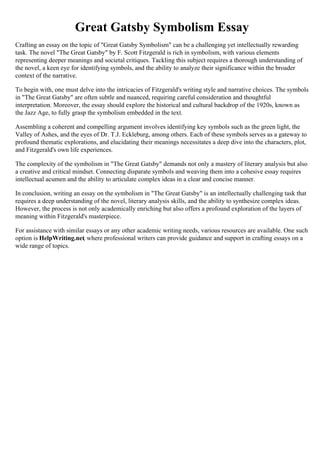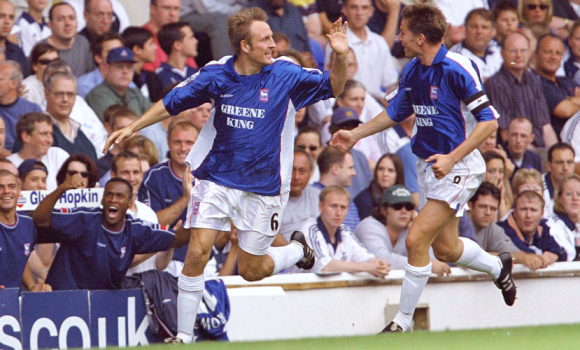The Great Gatsby: Fact And Fiction – Identifying Fitzgerald's Influences

Table of Contents
Fitzgerald's Life: Echoes in Gatsby's Story
Fitzgerald's personal life profoundly influenced the narrative and characters of The Great Gatsby. His tumultuous relationship with Zelda Sayre, his struggles with wealth and social status, and his keen observation of the excesses of the Jazz Age all echo within the novel's pages. Understanding Fitzgerald's biography provides crucial context for interpreting the novel's themes and characters.
-
Fitzgerald's courtship of Zelda: This parallels Gatsby's obsessive pursuit of Daisy. Both men were driven by a powerful love for a woman who initially rejected them, highlighting the themes of ambition and the American Dream, albeit with vastly different outcomes. Fitzgerald's own persistent wooing of Zelda, eventually culminating in marriage, mirrors Gatsby's relentless efforts to recapture the past.
-
His struggles with wealth and status: Fitzgerald himself experienced periods of both affluence and financial hardship. This resonates powerfully with Gatsby's nouveau riche status and his desperate yearning for acceptance into the established elite of East Egg. The novel reflects Fitzgerald's own anxieties about social mobility and the elusive nature of true belonging within high society.
-
The influence of the Jazz Age and its excesses: Fitzgerald was deeply immersed in the vibrant and often chaotic culture of the Roaring Twenties. His firsthand experience with the era's extravagance, hedonism, and underlying moral decay are vividly portrayed in Gatsby's extravagant parties and the overall atmosphere of the novel. The Jazz Age's influence on Fitzgerald's writing is undeniable, shaping both the style and substance of The Great Gatsby.
-
Analysis of Fitzgerald's own complex relationships: The dynamics between Fitzgerald, Zelda, and their social circle inform the complex relationships between Gatsby, Daisy, Tom, and Jordan. Fitzgerald’s own experiences with infidelity, social climbing, and disillusionment are mirrored in the characters' actions and motivations.
Historical Context: The Roaring Twenties and Beyond
The Great Gatsby is not only a product of Fitzgerald's personal experiences but also a reflection of the broader historical context of the 1920s. The Roaring Twenties, a period of rapid social and economic change, significantly shaped the novel's narrative.
-
The impact of Prohibition: The era's ban on alcohol fueled the growth of speakeasies and underground culture, directly influencing the novel’s depictions of lavish parties fueled by illicit liquor. Gatsby's parties serve as a potent symbol of the era's excesses and the moral ambiguity of the time.
-
The social stratification of the era: The stark contrast between the wealthy elite of East Egg and the newly rich of West Egg mirrors the significant social stratification of the 1920s. This division reflects the anxieties surrounding class mobility and the challenges faced by those seeking upward social advancement.
-
The changing roles of women: The portrayal of Daisy Buchanan reflects the shifting societal expectations for women in the 1920s. While enjoying newfound freedoms, women still faced limitations within a patriarchal society, a theme explored through Daisy’s complex character.
-
The disillusionment following World War I: The post-war disillusionment and cynicism that permeated American society following World War I profoundly affected Fitzgerald's writing. This manifests in the characters' moral ambiguity and the underlying sense of hollowness that characterizes the novel's glittering facade.
Real-Life Inspirations: Prototypes for Gatsby and Daisy
While The Great Gatsby is a work of fiction, it is widely believed that several real-life figures served as inspiration for its characters.
-
Identifying potential real-life models for Jay Gatsby: Several individuals have been suggested as possible prototypes for Gatsby, including bootleggers and other wealthy figures from Fitzgerald's social circles. Analyzing these potential inspirations sheds light on the construction of Gatsby's character and his self-made wealth.
-
Exploring possible influences for the character of Daisy Buchanan: Similarly, Daisy's character might be based on several women from Fitzgerald's life, including Zelda Sayre herself. Comparing the fictional Daisy to these potential real-life counterparts helps in understanding the complexities of her character.
-
Comparing the fictional characters to their potential real-life counterparts: Examining the similarities and differences between the fictional characters and their potential real-life inspirations reveals how Fitzgerald transformed his observations into powerful fictional narratives.
The Power of Symbolism: Fact Woven into Fiction
Fitzgerald masterfully employs symbolism to convey deeper meanings within The Great Gatsby. These symbols are not simply arbitrary devices; many are deeply rooted in historical realities and Fitzgerald's personal experiences.
-
Analysis of the green light as a symbol of hope and the unattainable: The green light across the bay becomes a powerful symbol of Gatsby's yearning for the past and his relentless pursuit of an idealized version of Daisy.
-
The significance of Gatsby's parties and their representation of excess and emptiness: The extravagant parties symbolize the excesses of the Jazz Age, but also highlight the underlying emptiness and superficiality of the wealthy elite.
-
Interpreting the symbolism of the Valley of Ashes and its portrayal of social decay: The Valley of Ashes serves as a stark visual representation of social decay and the moral degradation that underlies the glittering facade of wealth and prosperity.
-
Exploring the symbolic representation of wealth and class in the novel: The geographical division between West Egg and East Egg highlights the social stratification and the complex relationship between wealth, power, and social status.
Conclusion
By examining Fitzgerald's life, the historical backdrop of the Jazz Age, and the potential real-life influences, we gain a deeper appreciation of the complex interplay of fact and fiction in The Great Gatsby. The novel is not merely a fictional narrative but a powerful reflection of a specific time and place, shaped by both the author's personal experiences and the broader societal context. Understanding the factual influences on The Great Gatsby enriches the reading experience and allows for a more nuanced interpretation of its enduring themes. Delve deeper into the fascinating connection between fact and fiction in Fitzgerald's masterpiece – explore further research into the life of F. Scott Fitzgerald and the historical context of the 1920s to fully appreciate the lasting impact of The Great Gatsby.

Featured Posts
-
 Lily Collins Stars In A New Calvin Klein Campaign See The Photos
May 11, 2025
Lily Collins Stars In A New Calvin Klein Campaign See The Photos
May 11, 2025 -
 A Crazy Rich Asians Tv Series Is Officially Happening Heres What To Expect
May 11, 2025
A Crazy Rich Asians Tv Series Is Officially Happening Heres What To Expect
May 11, 2025 -
 Trumps Plan To Restrict Migrant Detainment Challenges
May 11, 2025
Trumps Plan To Restrict Migrant Detainment Challenges
May 11, 2025 -
 Ipswich Towns Sheehan Addresses Recent Defeat A Positive Outlook
May 11, 2025
Ipswich Towns Sheehan Addresses Recent Defeat A Positive Outlook
May 11, 2025 -
 Eric Antoine Qui Est La Femme Qui L Accompagne A La Premiere Parisienne
May 11, 2025
Eric Antoine Qui Est La Femme Qui L Accompagne A La Premiere Parisienne
May 11, 2025
